|
1. CENTRAL/ WEST AFRICA
Prices for West African logs show slight strength
Over the last fortnight, prices for some West African log
species have shown some strength where there has been
demand from India, China and Vietnam. However, the
majority of prices were unchanged due to the dull market
conditions. A few species have shed around EUR3 to
EUR5/m³ or so through lack of buyer interest rather than
the result of actual sales. Demand has been only moderate
and exporters had no great expectations of any sudden
revival in the short to medium term, and production
remains at an ongoing low level.
Europe was still very quiet and demand for logs for
traditional French and German buyers was extremely
limited. Sawn lumber prices were stagnant and seem likely
to remain so through the current quarter. Even the
European spring weather that usually turns buyers’ minds
towards topping up stock levels for a more active phase in
building activity has this year not led to a rise in inquiries,
and even fewer new contracts. Sapele prices were still low,
while other prices seem once again to be unchanged. West
African sawmills in most areas have either closed or were
operating at low capacity. In other news, the Gabon
government released details of the 2009 log quota, which
is set at just above 1.5 million m³.
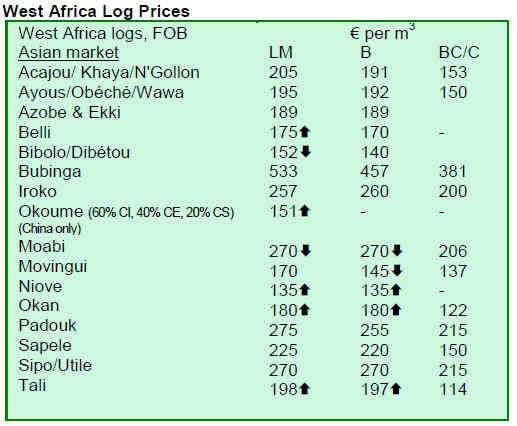
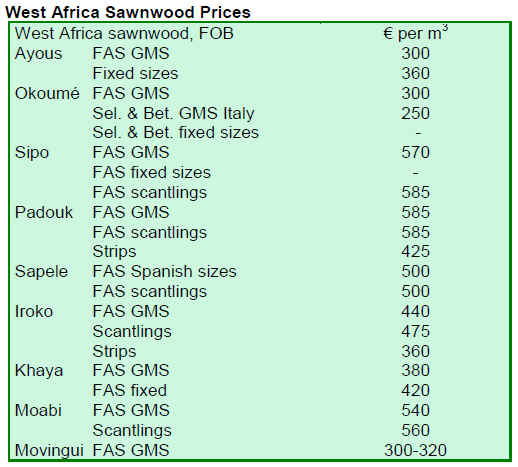
2. GHANA
Plywood contracts show gains in fourth quarter 2008
A total contract volume of 152,244 m³ and 9,507 pieces of
furniture parts were processed and approved during the
quarter under review. These represent drops of 10.2% and
38.2% respectively, when compared to the figures
achieved during the third quarter of 2008. With the
exception of plywood contracts, which increased 68.3%,
and were 75,882 m³ by volume, the volume of contracts
processed and approved for all major exportable products
fell during the quarter under review when compared to the
previous quarter.
Export volumes of lumber, rotary veneer and sliced veneer
decreased by 26.5%, 9.8% and 7.5% respectively. There
was a sharp drop in the export volume of
logs/poles/billets, which were 13,732 m³, representing a
decrease of 70.95% when compared to the previous
quarter. The difficulty in securing contracts from the
European and the American markets shifted the attention
of most integrated mills to the West African sub-region
where plywood is readily available. This resulted in a
high volume of plywood contracts being issued during the
quarter under review. Plywood contributed 49.8% to the
total wood products export volume.
The TIDD contract offices in Kumasi, Accra and Sunyani
processed and approved 14.5%, 0.5% and 48.5%,
respectively, of total wood products approved during the
quarter under review. These three offices together
contributed 63.5% of the total volume of wood products
approved. The high percentage of contracts attributed to
the Sunyani office was mainly due to the high volume of
plywood approved during the quarter. The office
approved 58,607 m³ of plywood, representing 38.5% of
the total contract volume.
Regarding price and market performance, prices were
generally down, especially during the last month of the
quarter under review. This has been attributed to the
global economic downturn and the credit crunch in
Germany, the UK, Italy and the US, the major destinations
of Ghana’s wood products. Inquiries from most buyers
also revealed that this situation has seriously affected the
building industry, which is the main consumer of Ghana’s
wood products. It has become very difficult to obtain
credit from financial institutions and debtors have taken
advantage of the situation by not paying for already
bought timber.
Prices generally dropped between EUR5/m³ and
EUR20/m³ below the TIDD minimum Guiding Selling
Prices (GSP) for lumber and rotary veneer. Odum lumber,
for example, fell as low as EUR40/m³ below the TIDD
minimum Guiding Selling Prices (GSP). Notwithstanding
the above, plywood to West African markets performed
notably well during the quarter under review. Depending
on the thickness, plywood prices increased between
USD10/m³ and USD50/m³ over the TIDD minimum
Guiding Selling Prices (GSP).
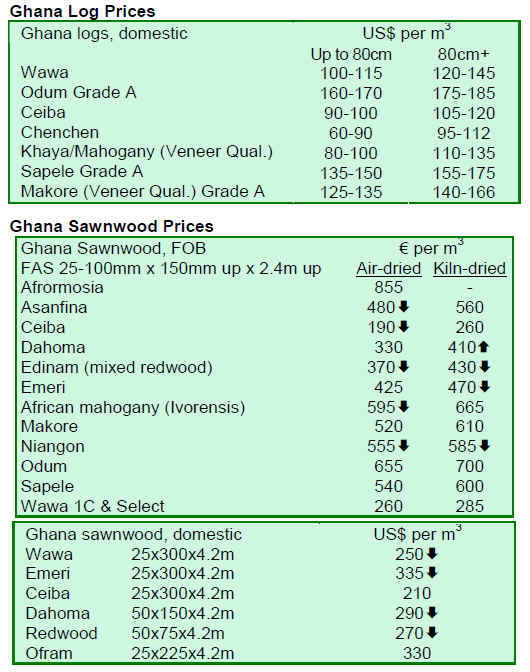
3. MALAYSIA
Sarawak state government reduces timber royalty
The Sarawak state government has reduced the 2009
timber royalty to a flat rate of RM50 for all timber with a
diameter of 30cm or more, reported The Star. The
reduction derived from an appeal by the Sarawak Timber
Association (STA), after the state forestry department had
increased the royalty to RM65 four months ago. However,
the government rejected STA’s appeal for a 50% discount
on the timber royalty extracted from agri-conversion land
and for timber with a diameter of between 30cm and
40cm. The royalty will increase to RM55 by 2010 and
RM65 in 2011.
Minister expects exports to reach RM20 billion
According to Bernama, Deputy Plantation Industries and
Commodities Minister Mr. A. Kohilan speculated that
demand for Malaysian timber products from Central Asia,
India and Eastern Europe could help Malaysia achieve at
least RM20 billion in exports in 2009. He also said the
federal government has launched an afforestation
programme, which is managed by the Malaysian Timber
Industry Board (MTIB). A target of 25,000 ha has been
earmarked for afforestation yearly over a period of 15
years, which would result in a total of 375,000 ha
afforested. Fourteen companies are said to be participating
in this programme, with an area of nearly 60,000 ha
afforested to date.
Malaysia’s exports fall 15.9% in February
Malaysia’s exports fell 15.9% in February 2009, when
compared to February 2008 exports, as reported on
CNBC.com. Exports in January 2009 declined 27.8%
compared to the previous year, the steepest decline in
nearly 30 years. Economists commented that the current
economy is performing better than predicted, but
cautioned that a decline in exports at least over the next
few months will hover in the realm of 20%.
Timber prices steady but may not hold
Prices of Malaysian timber products remain weak but
steady as thunderstorms continue to hammer the country,
making timber extraction difficult. However, prices are not
expected to hold. Foreclosures of both private and
commercial properties were on the increase in the wake of
massive layoffs by major MNCs and a slump in domestic
demand. At the forefront of the layoffs were suppliers of
major building/construction material and household
accessories.
Prices of residential properties, often propped up by
foreign investors and speculators, may actually decline for
the first time. Some analysts commented that the
Malaysian economy will take 2 to 3 years to recover, and
will do so only after there is some upturn in the US
economy.
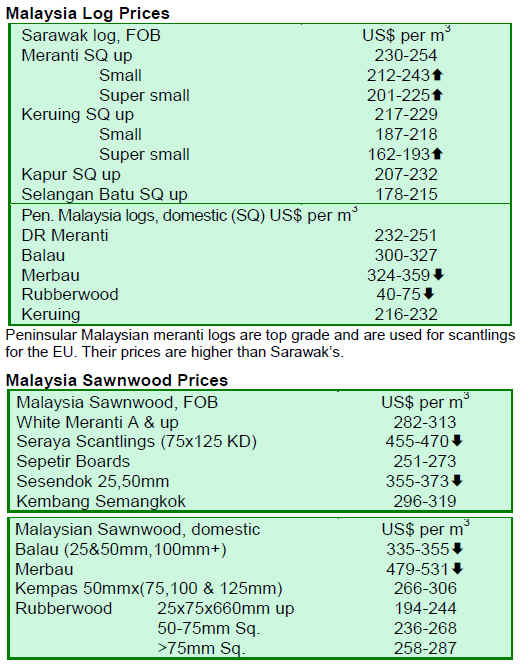
4. INDONESIA
Indonesian economic stimulus package to be released soon
According to Antara News, the Indonesian government is
currently processing its Rp73.3 trillion economic stimulus
package and will begin to allocate funds by end April
2009. Indonesia, the most populated state in South-East
Asia has been facing its worst recession in modern history.
The government was hopeful the stimulus would help
address the various issues posed by unemployment in the
country.
Sales of forestry equipment plunge for PT United Tractors
Forestry Minister MS Kaban said ‘chronic ailments’
affecting Indonesian forests would take a long time to fix.
As reported in Antara News, the minister indicated weak
government control and mismanagement by forest
concessionaries, timber estates and licensed plantations
had contributed to the damage in the forests. Kaban noted
the ailments were also affecting forest industries and
timber companies, which had cut the state’s foreign
exchange earning and spurred illegal logging and theft. To
address some of these problems, Kaban drew attention to
forest plantation activities undertaken by the government
on the last three years, during which a total of USD1.9
million trees had been planted and which were expected to
boost recovery of the forests.
Price declines trigger fears for mill owners and workers
Reports are emerging that some sawmill and plywood mill
owners in Indonesia may resort to arson to recoup their
financial losses from recent months. Prices of Indonesian
timber products declined sharply as exporters to traditional
markets, e.g. Japan and the US, struggle under the weight
of heavy corporate debts.
Potential investors in the Indonesian timber industry added
that aging machinery, poor infrastructure and illiteracy are
some of the biggest hindrances to investors. The high rate
of illiteracy in Indonesia makes it difficult for companies
to train and provide skilled workers required by the
downstream and value-added timber industry.
Experts also noted that any collapse in prices of
Indonesian timber products could trigger a similar chain
reaction among timber producers in the region.
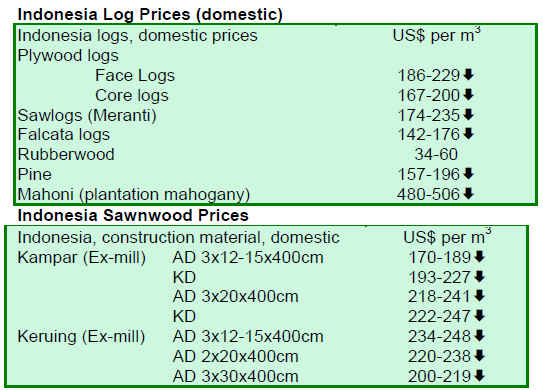
5. MYANMAR
Low trade expected as a result of holiday period
Analysts expect not much work to be undertaken during
April, with stock taking being done at the end of the
Myanmar fiscal year and the Myanmar new year holiday,
which occurs during 11-21 April. The last tender on 30
April resulted in some price rises for specific grades.
Nevertheless, the quantity traded was small, so the price
gains do not reflect the actual state of the market. April’s
tender prices will be in FOB prices, with the remaining
sales being done on an ex-works basis. Most analysts
believe this will keep prices up, unless log parcels are
graded poorly. The tender lots were reported to be mostly
above average in quality.
In general, the market was reported to be very slow. Not
many new orders for sawn teak were reported. However,
some reports indicate the log market was showing slightly
increasing strength. One analyst expected the situation to
become clearer around June.
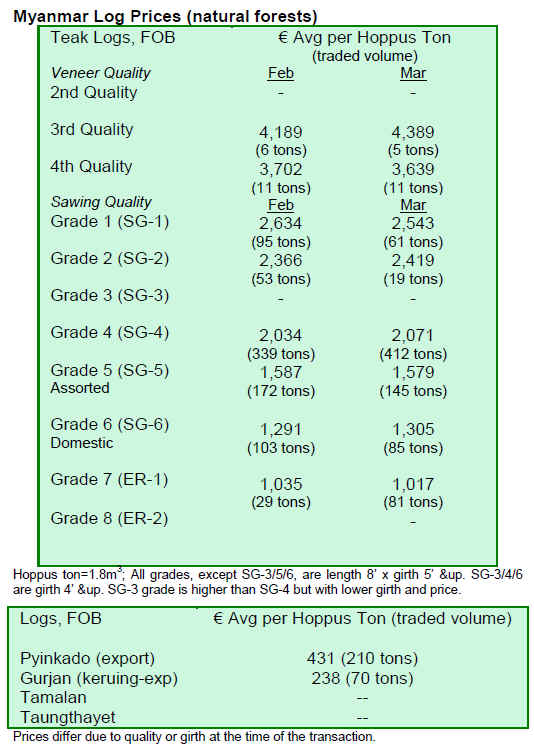
6. BRAZIL
AIMEX anticipates future problems in Pará’s forest sector
According to Folha do Progresso, the Association of
Timber Exporters Industries of the State of Pará (AIMEX)
has indicated 2009 will be a problematic year for the forest
sector in Pará. Exports from the state in January and
February 2009 fell 60% by value and 65% by volume
when compared to year 2007 results. Entrepreneurs
working in the international market have recognized the
global economic crisis has strongly impacted Pará’s
industrial and manufactured timber products trade.
However, the delay in government approval of
environmental permits has been cited as the primary
reason for the current difficulties. Many noted that
negative indicators in Pará’s timber sector have preceded
the economic downturn, seemingly due to the delay in
permit approval and the lack of available raw material,
which has lasted for nearly five years.
The situation has become so serious that the state of Pará
has begun to import timber, particularly from Bolivia. Pará
was also buying timber from planted forests in other
Amazonian states. These are considered emergency
measures to meet the terms of the medium and long-term
contracts with the European and American markets.
According to AIMEX, these are illustrations of the crisis
facing the forest sector over the last two decades.
Experts have urged the government to set policies that
promote forest activities. Representatives from the timber
sector have asked the government to invest quickly in
forest concessions and forest plantation policies. AIMEX
has said, given the timber sector’s severe financial crisis,
the state government should take concrete actions to
reduce the impact of the crisis in Pará’s economy. AIMEX
also stressed that measures recently undertaken by the
government, including the restructuring of the State
Secretariat of the Environment (SEMA), were positive, but
were insufficient to cope with an unprecedented crisis like
the current one.
IBAMA and SEMA on the hunt for ‘ghost companies’
The Brazilian Institute of Environment and Renewable
natural Resources (IBAMA), in collaboration with the
Pará Secretary of the Environment (SEMA) and IBAMA
regional offices, has continued to conduct investigations to
identify ghost companies, which have fraudulently
engaged in trade of forest products and by products.
According to EcoDebate, the investigations, which were
started in March 2009 (see TTM 14:5), have already
stopped more than 100 companies selling illegal timber in
the state capital (Belem) and other timber clusters of the
state. According to the IBAMA regional office, the
operation has generated nearly BRL100 million in fines,
and fines are expected to reach over BRL1 billion at the
end of the operation.
The operation focuses on companies that exist only on
paper. The ghost companies are established to create a
façade for the company to sell illegal products from
protected areas, public forests and indigenous lands. In
2008, illegal trade in these products was responsible for
over BRL 250 million. As part of the operation, IBAMA
and its partners will block the operation of the ghost
companies and seize any illegally traded timber or
charcoal from the company. The amount of logs and
charcoal seized so far has reached 10,000 m³ and 5,000
m³, respectively.
Business events expected to generate nearly USD13
million for furniture exporters
The ‘International Purchaser Project’ Fair, held from 10-
12 March at the Movelpar 2009 Furniture Fair in the state
of Paraná, promoted 402 businesses among 20 importers
and 48 furniture manufacturers, fair exhibitors and
participants, and was organized by Apex Brazil and
ABIMOVEL (the Brazilian Furniture Association).
Research conducted among importers from 17 countries at
the Movelpar Fair indicated 75% of the meetings resulted
in prospects for future business, estimated at USD12.9
million by value. A survey among the furniture producers
indicated deals closed at the end of the business rounds
were worth about USD3.8 million.
Portal Moveleiro has reported that one of the main
obstacles for furniture manufacturers to overcome is the
export crisis. Recently, Brazil has had to undertake
measures to maintain its competitiveness in international
markets. In recent months, the federal government had
been asked to reduce taxes on particleboard imports to
maintain the furniture sector’s competitiveness.
Additionally, ABIMOVEL is establishing a partnership
with design professionals to produce high quality furniture
in order to heighten its competitiveness in the international
market. To some, Brazil is considered to be more
competitive than China in the international furniture
market, since Brazil is known for having higher raw
material quality and design. According to ABIMOVEL,
Chinese furniture is more expensive due to a number of
factors, including freight costs for exports and a reduction
in the weekly working hours now set at 40 hours, whereas
Brazilian workers clock over 44 hours.
Brazil exports about 10% of its furniture production.
According to the Federal Secretary of Foreign Trade
(SECEX), furniture exports fell 1.7% in 2008 compared to
2007. In January 2009, it dropped 27.4% compared to
January 2007. Despite these negative indicators, there is a
prospect of a 5% increase in sales to the domestic market
and a 3% rise in sales to the international market.
ABIMOVEL is also requesting the federal government
reduce tax on industrialized products (IPI) from 10% to
5% and to include the furniture sector in the Growth
Acceleration Program (PAC) for housing, which is
expected to cost about BRL90 billion by 2010.
Furniture exports to Argentina drop 51%
Sharp declines in Brazilian furniture exports to Argentina
have been appearing, similar to a cycle observed in 2000
and 2001. This has been caused by a strong deceleration of
the Argentinean economy, noted Gazeta Mercantil. The
Association of Furniture Companies of Rio Grande do Sul
(MOVERGS) reported that in the first bi-month of 2009,
Brazil’s exports to Argentina were 51% less than the same
period of last year (USD6.4 million in 2009, compared to
USD13.1 million in 2008).
This was the worst fall since 2004. The average annual
growth in exports to Argentina between 2004 and 2008
was 72% per year. However, the average drops to 39.5% if
the first two months of 2009 are included. The annual
average growth rate of Brazilian furniture exports between
2004-2008 was 10.6%, but if including results from the
first two months of 2009, it slows down to only 2.1%.
Additionally, a new trade rule in Argentina requires
importers to have an import license for Brazilian furniture
products, which is considered to some a new obstacle in
the bilateral relationship. The measure has been the subject
of negotiation between the governments. Venezuela has
already adopted the license system and Ecuador has
recently increased import tax from 24.5% to 60.5%. These
markets do not have enough mills to meet their demand.
One-third of shipments of Brazilian furniture go to the
European Union (EU). However, the situation there is not
unlike that in Argentina. In the first two months, exports to
France decreased 38.6%, 19.1% to the United Kingdom,
11.1% to Germany, 11.5% to the Netherlands and 50% to
Spain. Brazil closed its January - February balance with a
31.7% drop in furniture exports over the same period of
2008 (USD96.5 million against USD141.2 million in
2008).
Leadership transition in Brazilian Forest Service
Antonio Carlos Hummel has been appointed the new
Director General of the Brazilian Forest Service (BFS),
replacing Tasso Azevado. Azevedo will now act in the
capacity of special advisor to the Minister on forest and
climate change issues and on matters relating to the
Amazon Fund, an organization implementing forestry
projects in that region. The new Director General of the
BFS has been a career employee of IBAMA and in the last
six years was responsible for overseeing the Department
of Biodiversity and Forests. He has extensive experience
on forestry issues, especially in the institutional
development of the sector. As director of the BFS, he will
be responsible for implementing and expanding the
Brazilian forest concessions and for sustained production,
and will oversee BFS’s role as focal point of the ITTO for
Brazil.
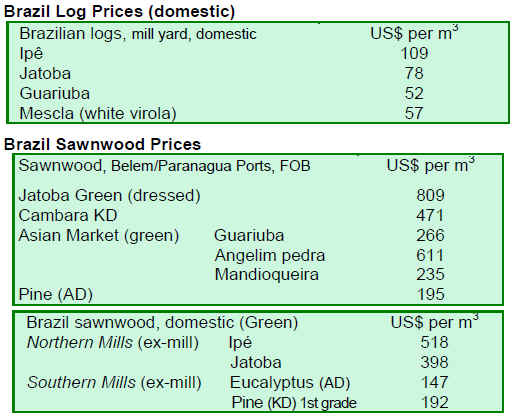
7. PERU
Early 2009 exports drop 50%
According to the Export Association of Peru (ADEX),
Peru’s wood exports from January-February 2009 dropped
50% by value, when compared to the previous year.
Exports also fell to USD19.6 million during 2009 from
USD39.2 million from the same period in 2008.
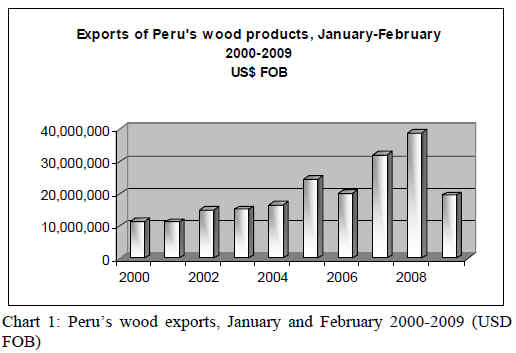
Sawnwood represented 37.6% of sector exports. Exports
in January-February 2009 were just over USD7 million,
while for the same period in 2008 exports were USD20
million, a year-on-year decrease of 63%. The main
markets for this sub-sector were Mexico, China, the US,
and the Dominican Republic, which received 41%, 22%,
14%, 8% of sawnwood exports, respectively.
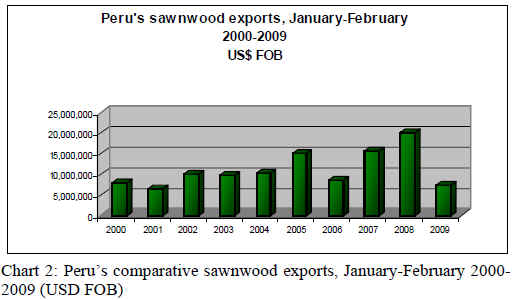
Semi-manufactured products accounted for 42% of wood
sector exports and ware the principal export item in the
wood sector. Exports in January-February 2009 were
valued at USD8.3 million, while exports for the same
period in 2008 were valued at USD10.3 million, marking a
19% drop in exports against 2008 levels. The main
markets for this sub-sector were China, the US and Hong
Kong, which received 80%, 9% and 5% of semimanufactured
products, respectively.
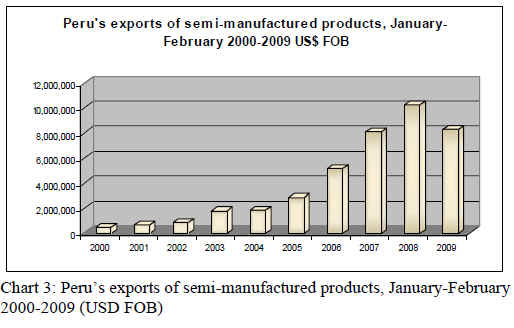
Veneer and plywood exports for the January-February
2009 period were USD1.7 million, while exports for the
same period in 2008 were valued at USD4.7 million,
falling 62.6%. Results from the sub-sector show Mexico
as the main market for Peru’s exports (78.7%) followed by
Venezuela (15.4%), with other countries making up the
remaining 5.9%.
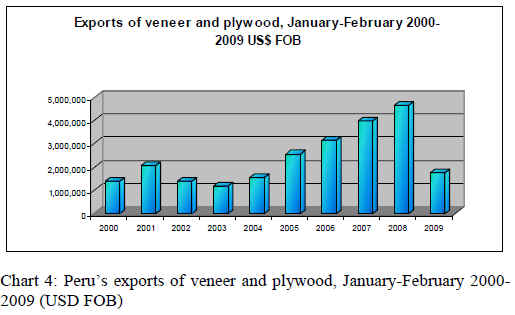
Furniture exports were worth a value of USD1.1 million
during the January-February 2009 period, a 56.2%
decrease from the same period in 2008. The main market
destination for these products was the US (58.7%),
followed by Italy (21.5%).
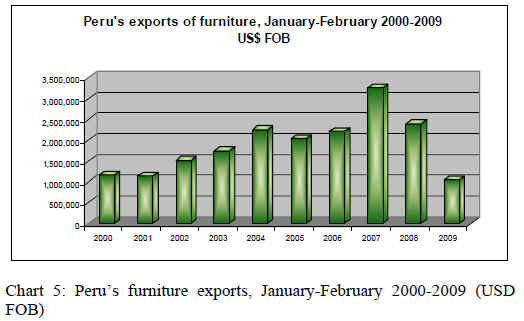
During the January-February 2009 period, exports were
concentrated in three markets representing 81.1% of total
wood products exports. China represented 42.6% of
exports in the sector, dropping 6.5% when compared to the
previous year. Mexico followed, receiving 23% of exports,
although this was a 70% drop in exports received in the
previous year. The US was the third destination market,
representing 15.3% of exports, although its level of
imports has fallen 68.9% when compared to the same
period in 2008.
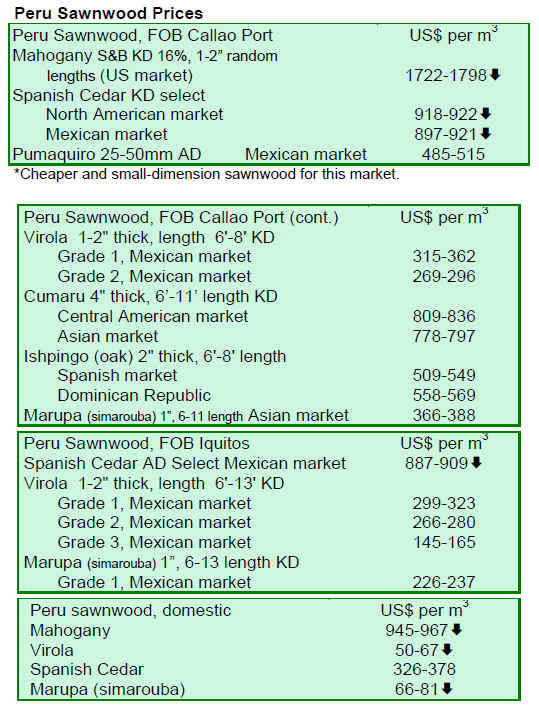
8. BOLIVIA

9. Mexico
Mexico lowers annual deforestation average
Mexico’s annual average deforestation rate fell from
348,000 hectares to 260,000 during the period from 2000
to 2005, according to data provided by the national forest
inventory. This was considered encouraging for national
policies designed to improve the state of Mexico’s
vegetation and forests. This information on Mexico’s
deforestation rate was included in the State of the World’s
Forests 2009, published by the Food and Agriculture
Organization of the United Nations (FAO) and presented
at the nineteenth session of the Committee on Forestry
(COFO) in Rome, Italy, from 16-20 March 2009.
During the last decade, the financial resources invested by
Mexico have helped initiate or fortify processes of
community development in 2,000 agrarian centers. In the
present administration, this investment has reached 565
million pesos for communitarian forest management over
334,391 ha, through the national programmes ProTree and
the Programme of Communitarian Forest Development
(PROCYMAF). In the same period, it has addressed the
technical management of 3.6 million hectares of forest and
obtained sustainable forest management (SFM)
certification for over 244,719 ha of land.
Additionally, forest representatives of 115 countries
recognized Mexico’s contributions to mitigating climatic
change, to prevent deforestation and fight the poverty in
forest zones, particularly by way of community forest
management and application of SFM. At the COFO
session, Mexico suggested that SFM was an important
element to address climate change and noted SFM and the
Reduction of Emissions by Deforestation and Degradation
(REDD) should be more broadly addressed in UN
Framework Convention on Climatic Change. Mexico is in
the process of elaborating a national program on climatic
change and is considering how to adapt to and mitigate the
effects of the phenomenon.
10. Guyana
Guyana’s prices show relative stability
A comparison of prices from the period 16-31 March 2009
with the corresponding period in 2008 showed relative
stability in log prices. Sawnwood prices have shown
significant increases when compared to the same period of
2008. Plywood and roundwood prices have remained
stable for the same period in 2008. Value-added products
such as doors have shown a moderate increase in export
value when compared to same period. The Caribbean
market was the main destination for value-added exports.
Outdoor garden furniture for the period under
consideration recorded a comparatively high export value
to the UK market. Mouldings have also shown a higher
export value when compared to the same period of 2008.
Guyana to convene regional chainsaw milling workshop
A regional workshop on chainsaw milling in the Guiana
Shield/Caribbean will be convened in Georgetown,
Guyana within the framework of the project ‘Developing
alternatives for illegal chainsaw lumbering through multistakeholder
dialogue in Ghana and Guyana’. The chainsaw
milling project focuses on the broad theme of forest
governance in Ghana and Guyana, where there has been a
prevalence of chainsaw lumbering and different
approaches have been taken to regulate this activity. The
regional workshop targets decision-makers and scientists
in the regions where chainsaw lumbering activities occur
and aims to present issues and options for regulating
chainsaw lumbering.
The project, from which the workshop originates, is
funded by the EC and Tropenbos International and has
embarked on research into the causes and consequences of
chainsaw lumbering, to better understand the phenomenon
in Ghana and Guyana. This research is being compiled
into case studies for the two countries and will serve as
inputs into two regional meetings designed to identify the
main issues in West Africa and the Guiana
Shield/Caribbean region. The findings from the regional
meetings will be summarized in a synthesis paper that will
be discussed and refined with participation from experts
around the globe. The outputs of these exercises will be
documented and distributed in a publication of the
European Tropical Forest Research Network (ETFRN)
News.
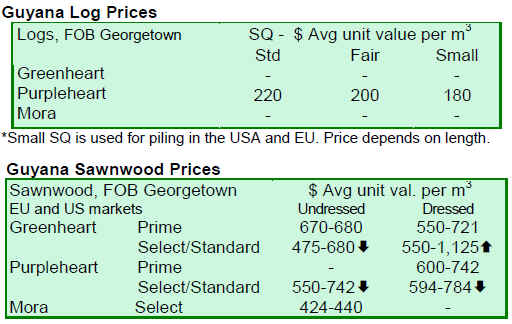
|